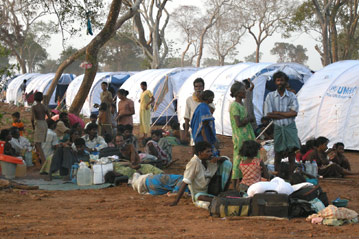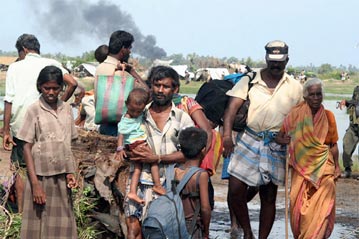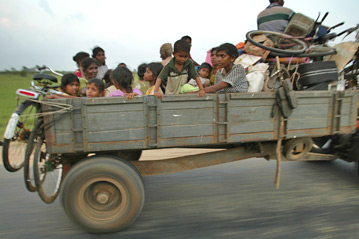UNHCR assists government with emergency response in Sri Lanka's north
UNHCR assists government with emergency response in Sri Lanka's north
As fierce fighting in Sri Lanka's north continues to result in mass displacement of innocent civilians, UNHCR and its partners are prepared to meet the immediate needs of up to 150,000 civilians fleeing from the conflict zones of Kilinochchi and Mullaitivu districts into government-controlled areas.
So far, more than 13,000 people displaced from conflict areas are being accommodated in several sites in the district of Vavuniya, the hub for emergency assistance in the north, as well as in Jaffna and the north-western district of Mannar. We have also received reports of another 5,000 people on the move who are expected to reach Vavuniya during the next 24 to 48 hours.
UNHCR has finalised a strategy on protection and emergency assistance for the new arrivals and is carrying out daily relief work at internal displacement and transit sites. As the lead agency for internally displaced people (IDPs), we have complete access to the sites.
At the same time, our office is in close dialogue with the Government of Sri Lanka on several protection concerns at the sites. We have called on the government to observe minimum standards at all these sites in line with international humanitarian principles. The government, in turn, has expressed its willingness to adhere to these standards and UNHCR awaits a concrete response to our démarches. More issues related to the protection of the IDPs are being discussed. We are also continuously advocating with the government on behalf of our partners for more access to the sites and greater involvement in the coordination mechanism in place for assistance activities. UNHCR will remain engaged with our government counterparts to ensure that any outstanding issues, protection or otherwise, are resolved.
Subsequent to the government's assurances, UNHCR has started to deliver assistance to civilians in government-controlled areas. A big part of our relief work takes place in Vavuniya, where more than 10,200 IDPs are being accommodated. UNHCR and its partners are constructing shelters at the largest site for new arrivals are we are also distributing non-food relief items.
Monitoring and assistance, including shelter construction, are also underway in IDP sites in the Mannar and Jaffna districts where UNHCR is coordinating emergency response to the new arrivals. Some 1,950 new arrivals are being accommodated in several sites in Jaffna and another 850 in the Mannar district.
As shelter construction and regular distribution of relief items takes place, UNHCR and other humanitarian agencies maintain additional stocks in the three districts to facilitate rapid response to the emergency needs of future waves of displaced from the conflict zone. UNHCR will observe developments during the coming weeks and will continue to support the government in providing assistance to those of concern as long as international humanitarian standards are upheld.
At the same time, we are outraged by the unnecessary loss of hundreds of lives and the continued suffering of innocent civilians inside the LTTE-controlled areas. We are calling upon both the government and the LTTE to halt indiscriminate fighting in close proximity to large concentrations of innocent people in the so-called safe zone. The safe zone is not consensual and does not meet any of the necessary international prerequisites. This has inevitably led to violations by both sides, putting the safety of the trapped civilians at even greater risk. Without respect for international humanitarian law by both parties, the bloodshed will continue.
Moreover, UNHCR condemns yesterday's suicide attack on a registration centre for new arrivals. The incident reportedly resulted in the deaths of 10 innocent civilians and wounded 40 others who were in search of safety. We also call on the LTTE to allow the remaining civilian population trapped inside the conflict zone to move to areas where they feel safe.







